Wine Accessories
Wine Accessories
Antique wine accessories such as Corkscrews, Tasters, Labels, Brandy Pans and Lemon Strainers were often made in silver and are a popular collecting field.
Silver Corkscrews were made for opening wine bottles and also for scent bottles. They are available in many different forms include travelling and novelty shapes.
Wine Tasters. The saucer shaped taster was already in use as early as the 14th century BC in Minoan Crete and has been essential in the production of wine right through to the present time. It is used by the sommelier to determine a wine’s quality by assessing the colour, clarity, bouquet and taste. The majority of wine tasters in existence are French. The owners often engraved their name on the taster whose single flat handle often accommodated a neck cord.
Very few English wine tasters were made because wine was not a national product however a number were produced during the 17th century. These English examples are rare and anything after this date is even rarer. Michael Clayton’s description of wine tasters in his “Silver and Gold in Great Britain and America” states that there are no undoubted wine tasters remaining in England dated earlier than 17th century although they certainly existed much earlier. The standard form is a shallow bowl with a raised centre, generally proud of the rim, against which the colour of the wine may be viewed. Tasters are normally circular about 10.2cm in diameter, however Clayton mentions a rare boat shaped example, hallmarked 1632, with a handle at one end, in a private collection. The placing of the hallmarks on an English wine taster indicates the way in which it is to be held and avoids any confusion with the trencher salt which has a dipped centre. Saucer shaped dishes and small, shallow, two-handed, dishes also existed at this time which could have been tasters but could equally have been sweetmeat dishes or receptacles for mixing sauces at table.
Brandy Saucepans made their first appearance in this country during the Queen Anne period and continued to be made until the mid 19th century. Some have spouts. The size varies but generally the early examples tend to be smaller. Sometimes they have three legs, these are called skillets, and they are quite rare.
Many Brandy Bowls are Dutch in origin. The two-handled bowls were used to celebrate childbirth but may have been passed around at other festive occasions as well when brandewijn, liquor distilled from wine to which sugar and raisins were added, would be served from them with a spoon.
Orange or lemon strainers were peculiar to the 18th century and were probably used in conjunction with punch bowls to filter out the fruit pips. They were made with one or two handles. The one handled strainer sometimes had a small tongue or lug on the opposite side of the handle which may have been used to hook it on to the side of the punch bowl. The strainers are normally marked in the piercing in the centre of the bowl. These strainers are popularly used nowadays as tea strainers although the size is larger than a normal tea strainer.
Wine Labels, also known as “bottle tickets”, appear to have originated in the second quarter of the 18th century. They were made in many attractive designs and are a popular collecting field. Generally, the label is suspended around the neck of the bottle by a chain, although some are formed as plain collars which slip over the neck, or formed as a plain rectangle hinged from a wire ring. Among the many good makers are Hester Bateman and family, Phipps & Robinson, Samuel Bradley, Mary Binley and Paul Storr.
-

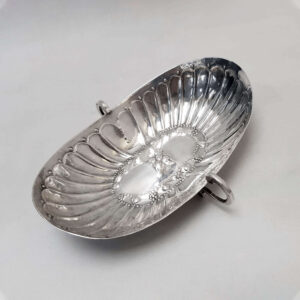
1641
10277 Charles I Antique Silver Wine Taster
An early English silver taster of a rare boat shaped form with simple shaped side handles. The decoration is typical for the period, the body having a fluted design with punched dots and a flower head to the centre. Dishes from this period are occasionally referred to as sweetmeat dishes. Weight 88 grams, 2.8 troy ounces. Length 15.2cm. Width 9.6/12.5cm. Height 2.2/3.9cm. London 1641. No maker’s mark. Sterling silver. 17th century.
-

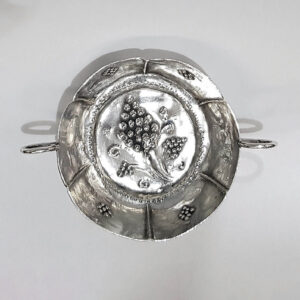
Circa 1670
10393 Charles II Antique Silver Miniature Wine Taster
A charming little early English miniature dish from the reign of Charles II. Very sweet size. This little cup has a circular form with simple wirework handles and an embossed grape decoration. Owner’s initials “AA” engraved to the top rim. Weight 12 grams, less than half a troy ounce. Height 1.5 cm approx. Diameter of top 5.2cm. Spread across handles 7.4cm. English, circa 1670. Unmarked sterling silver.
-

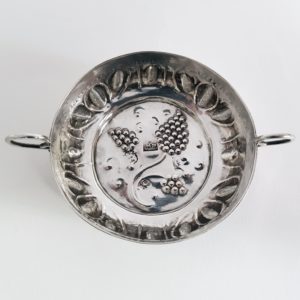
1673
George Watkins
10182 Charles II Antique Silver Wine Taster
A rare early English miniature wine taster from the reign of Charles II. Very charming size. This little cup has a circular form with simple wirework handles and embossed grape decoration. Weight 21 grams, less than 1 troy ounce. Height 2 cm approx. Diameter of top 6.1cm. Spread across handles 8.9cm. London 1673. Made by George Watkins. Sterling silver.
-

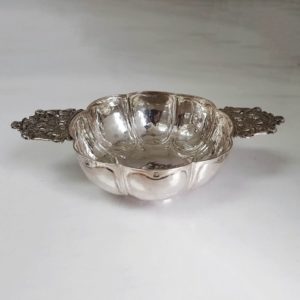
Circa 1685
9779 Antique Dutch Silver Brandy Bowl
An antique Dutch silver bowl with lobed decoration and cast pierced handles showing three children climbing on a grape vine. Good large size. Weight 213 grams, 6.8 troy ounces. Height 6cm. Spread 24.21cm. Diameter 14.3cm. Dutch silver marks for Haarlem 1740.
-

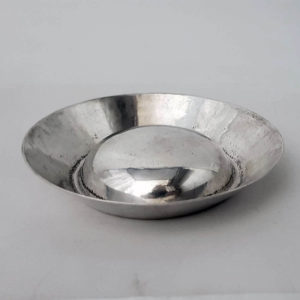
Circa 1700
9895 Antique Silver Wine Taster
Sold
A rare early antique silver wine taster of simple plain form in the shape of a flat bowl with a raised central dome. Very charming with the original hand beaten silver. At a later date the reverse side has been gilded for use as a trencher salt and the crest of a beaver holding a fish hand engraved to the front. Weight 78 grams, 2.5 troy ounces approx. Height 2.1cm. Diameter 11.47cm. Unmarked silver. Circa 1700. Probably English.
-

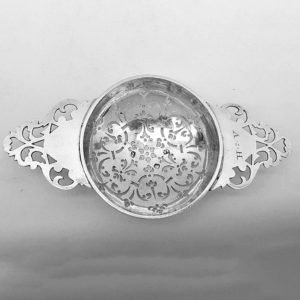
1722
John Albright
9942 George I Antique Silver Strainer
Sold
A rare early English antique sterling silver strainer of circular form with decorative side handles. A very charming and useful size; although originally made as a lemon strainer this could be used nowadays as a tea strainer. The bowl is pierced with a design of scrolls and other motifs and contemporary owner’s initials are engraved to one handle. Weight 75 grams, 2.4 troy oz. Spread 16.8cm. Diameter 8.5cm. Height 2.9cm. London 1722. Maker John Albright. Sterling silver
-

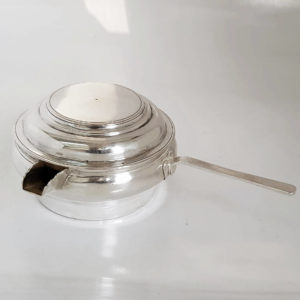
1769
8310 Antique Russian Silver Brandy Sauce Pan
A Russian silver brandy warmer with simple plain styling. Good early date. The circular bowl has a reeded border, flat handle and pull-off cover. Original gilt interior. Weight 284 grams, 9.1 troy ounces. Diameter 11.5 cm. Spread 20 cm. Height 7 cm. Marked on lid and base with Russian silver marks, 84 and makers mark. Date mark for 1769.
-

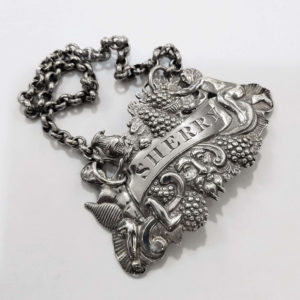
1818
Edward Thomason
10272 George III Antique Silver Wine Label
A very decorative antique silver bottle ticket with a silver chain. The elaborate bacchanalian scene portrays two cherubs holding flagons of wine surrounded by grape and vine leaf decoration and a face mask below. Engraved “SHERRY” to the scroll centre. Weight 17 grams, less than 1 troy oz. Measures 6 x 4cm. Birmingham 1818. Maker Edward Thomason. Sterling silver. 19th century.
-

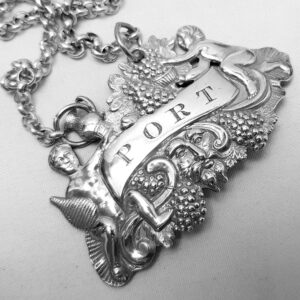
1818
Edward Thomason
10290 George III Antique Silver Wine Label
A very decorative antique silver bottle ticket with a silver chain. The elaborate bacchanalian scene portrays two cherubs holding flagons of wine surrounded by grape and vine leaf decoration and a face mask below. Engraved “PORT” to the scroll centre. Weight 13 grams, less than 1 troy oz. Measures 6 x 3.6cm. Birmingham 1818. Maker Edward Thomason. Sterling silver. 19th century.
-

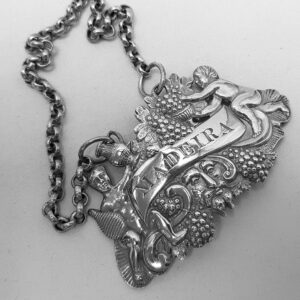
1818
Edward Thomason
10291 George III Antique Silver Wine Label
A very decorative antique silver bottle ticket with a silver chain. The elaborate bacchanalian scene portrays two cherubs holding flagons of wine surrounded by grape and vine leaf decoration and a face mask below. Engraved “MADEIRA” to the scroll centre. Weight 16 grams, less than 1 troy oz. Measures 6 x 3.6cm. Birmingham 1818. Maker Edward Thomason. Sterling silver. 19th century.
-

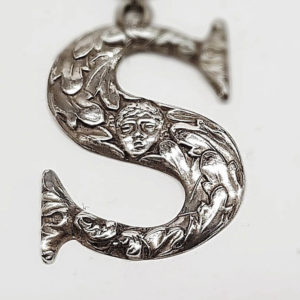
1819
Joseph Willmore
9483 Georgian Silver Wine Label
Sold
An unusual antique sterling silver bottle ticket with a silver chain. Cast in the form of the letter “S” the label has leaf and face mask decoration. Weight 5 grams. Measures 2.5 x 1.9cm. Birmingham 1819. Maker Joseph Wilmore.
-

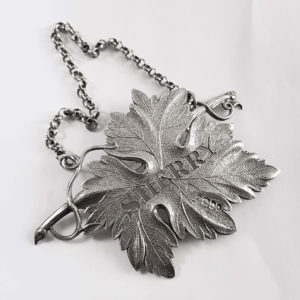
1826
Thomas Edwards
9772 Antique Silver Wine Label
A handsome antique sterling silver bottle ticket in the form of a vine leaf pierced for SHERRY. Good decorative detail. Weight 22 grams, less than 1 troy ounce. Measures 8.5 x 5.8 cm. London 1826. Maker Thomas Edwards. Sterling silver.
-

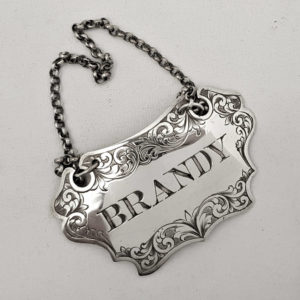
1864
Henry Aston
7976 Victorian Silver Brandy Label
A very pretty antique silver label with shaped border and the word “BRANDY” engraved on the front. The front has hand engraved bordered of leaf scrolls. Weight 9 grams. Measures 5.5 x 3 cm. Birmingham 1864. Maker Henry Aston.
-

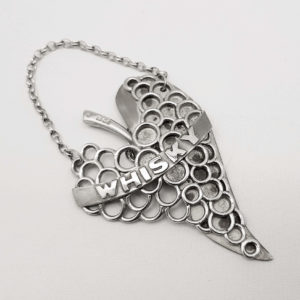
1992
C.J. Vander
9752 Vintage Silver Spirit Label
A modern silver bottle ticket in the stylised form of a cast vine leaf with pierced cluster of grapes. “WHISKY” is applied across the curved title scroll. Numbered ‘14’ on reverse. Weight 49 grams, 1.5 troy ounces.Measures 8cm long. London 1992. Maker C.J. Vander Ltd, London. Sterling silver.